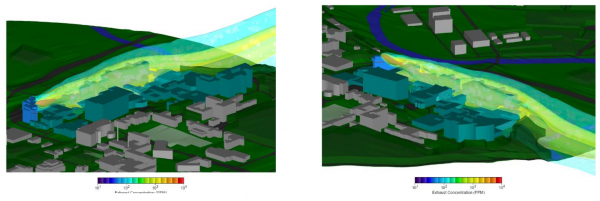ASC uses computational fluid dynamics (CFD) to model the dispersion of gases and particulates to predict their behavior in real-world environments under a range of different ambient wind conditions and flow rates. A three-dimensional CFD model can be constructed of the exterior of buildings and the surrounding community, with exhaust gasses tracked. ASC’s solutions provide insights into airflow patterns, pollutant spread, and potential exposure risks.
Project Examples Include:
-
Medical Campus Laboratory Plume Dispersion Modeling: ASC was tasked, during an upgrade project of a medical facility, to evaluate the exhaust plume behavior over a range of potential system flow rates. A short video of the CFD simulation can be viewed here.

CFD color contour plots of exhaust concentration iso-surfaces
-
Dispersion Modeling Study for BESS Fire Tracking: Lithium-ion batteries stored in Battery Energy Storage Systems (BESS) have the risk of overheating, causing fires with concerning offgases. ASC, using CFD, provides energy companies with the tools to assess BESS fire risk, prioritize community safety, and protect their renewable energy assets. A short video of the CFD simulation can be viewed here.

CFD model of a Battery Energy Storage System Facility using Azore CFD
-
Natural Gas Compressor Station Venting: CFD flow modeling is used by gas companies to track the gas plumes in different wind conditions. ASC performed an external steady-state flow modeling of a natural gas compressor station to determine if vented gas would be ingested into a nearby pair of Simple Cycle gas turbines.
A short video of the CFD simulation can be viewed here.

Example of a potentially dangerous scenario with natural gas around occupied buildings and turbine intakes
-
Vehicle Exhaust Plume Behavior: ASC has conducted CFD and wind tunnel testing on large vehicles, including diesel engine trains, trucks, and ships that emit exhaust that can be dangerous to vehicle occupants and/or bystanders. View a short video by ASC's Engineering Director, Dr. Kevin Linfield here.

Exhaust plume dispersion with wind at 50 mph
-
Converting Boilers from Coal to Natural Gas: To reduce emissions, many U.S. power generators have been converting boiler fuel from coal to natural gas. These changes carry risks as coal-based plants don’t have built-in safety measures for gas leaks. ASC was tasked to prove out the room design for a boiler conversion. A short video of the CFD simulation can be viewed here.

Gas leak scenario from a boiler
